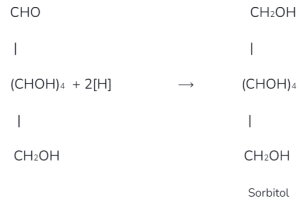Carbohydrates are composed of naturally occurring organic compounds of carbon-hydrogen and oxygen, which are primarily produced by plants. Carbohydrates are formed by plants by a process known as photosynthesis.
The general formula of carbohydrates is Cm(H2O)n
For example, carbohydrates such as glucose (C₆H₁₂O₆), fructose (C₆H₁₂O₆), and sucrose C12H22O11 satisfied this general formula.
There are some compounds that do not obey this formula; these compounds are carbohydrates by their chemical behavior, for example, deoxyribose and rhamnose. There are some other compounds that do not behave like carbohydrates but have the same formula of hydrates of carbon, such as formaldehyde.
Carbohydrates are classified into sugar, non-sugars, monosaccharides, oligosaccharides, disaccharides, tetrasaccharides, and polysaccharides.
The sugar that we most commonly use is called sucrose, and the sugar present in milk is known as lactose.
Monosaccharides and oligosaccharides are crystalline solids that are soluble in water and have a sweet taste; they are collectively called sugars. The polysaccharides are amorphous which are insoluble in water and tasteless they are known as non-sugars.
Glucose
Glucose occurs in nature in free and as well as in combined form. It is present in sweet fruits and honey. Dry grapes contain 20% of glucose. In combined form, it occurs abundantly in cane sugar and polysaccharides such as starch and cellulose.
Preparation of Glucose
From sucrose
When sucrose is boiled with dilute hydrochloric acid or sulphuric acid in an alcoholic solution, glucose and fructose are obtained in equal amounts.
![]()
From starch
Glucose is produced commercially from the hydrolysis of starch by boiling it with dilute H2SO4 at 390 k under the pressure of 2-3 atm.
![]()
Structure of glucose
Glucose is aldohexose which is also known as dextrose. It is a monomer of many of the larger carbohydrates such as star glycogen, cellulose, etc. Glucose is present abundantly on earth. It has an aldehyde group (-CHO), one primary alcoholic group, and 4 alcoholic secondary groups.

The structure of glucose was assigned on the basis of the following reactions.
Molecular formula
The formula of glucose has been found to be C6H12O6
Straight chain structure.
When an aqueous solution of glucose is added with sodium amalgam or sodium borohydride, it gets reduced to sorbitol or blue, which is hexahedral alcohol.

Prolonged heating with hydriodic and red phosphorus 100°C gives the mixture of n-hexane and to iodohexane.
CH2OH(CHOH)4CHO(glucose) → CH3(CH2)4CH3(n-hexane)+ CH3CH(CH2)3CH3 (2-Idodhexane).
As a result, The formation of n-hexane tells that all the six carbon atoms in glucose are arranged in a straight chain structure of glucose.
Presence of five hydroxyl groups
1.) In Acetylation, glucose reacts with acetic anhydride in the presence of anhydrous zinc chloride to form glucose Pentaacetate
CHO(CHOH)4CH2OH + 5(CH3CO)2O → CHO
|
(CHOCOCH3)4 + 5 CH3COOH
|
CH2OCOCH3(glucose pentaacetate)
- Presence of an aldehyde group
Reaction with hydrogen cyanide.
Glucose reacts with hydrogen cyanide to form cyanohydrin
CHO(CHOH)4CH2OH +HCN → CH2OH(CHOH)4CHCN (Glucose Cyanohydrin )
|
OH
- Action with hydroxylamine
Glucose reacts with hydroxylamine to form glucose oxime
CHO(CHOH)4CH2OH + NH2OH → CH2OH(COCH)4CH=NOH (Glucose Oxime) + H20
- Oxidation of glucose
The oxidation of glucose occurs,
When glucose gets oxidized to six carbon carboxylic acid or gluconic acid on reaction with a mild oxidizing agent like bromine water it indicates that the carbonyl group is present as an aldehyde group
CHO(CHOH)4CH2OH + [O] → COOH(CHOH)4CH2OH (Gluconic Acid)
Since the glucose is readily oxidized, it acts as the strong reducing agent as well as reduces tollen’s reagent and Fehling solution
CHO COONH4
| |
(CHOH)4 + 2[Ag(NH3)]2OH ⟶ (CHOH)4 + 2Ag + 3NH3 + H2O
| Tollen’s reagent | Silver mirror
CH2OH CH2OH
CHO COONa
| |
(CHOH)4 + 2Cu(OH)2 + NaOH ⟶ (CHOH)4 + Cu2O + 3H2O
| From Fehling solution | Red ppt.
CH2OH CH2OH
Strong oxidizing agents like nitric acid oxidize both terminals of glucose to give a diabetic acid saccharic, which is also known as glucaric acid, and this indicates the presence of the primary alcoholic group in glucose.
CHO(CHOH)4CH2OH + 3[O] → COOH(CHOH)4COOH (Saccharic acid and Glucaric acid)
Gluconic acid is obtained by the oxidation of glucose with bromine water, and H2O also gets oxidized with nitric acid to glucaric acid.
COOH(CHOH)4CH2OH +Br2 → COOH(CHOH)4COOH (Saccharic acid and Glucaric acid)
On the basis of all of the above reactions, German organic chemist (Fisher) introduced and opened the chain structure of glucose.
Conclusion
Glucose is an instant source of energy. It is important to note that in glucose, the -OH group at C3 chiral carbon is oriented towards the left while the remaining groups at C2, C4, and C5 chiral carbon atoms are oriented towards the right. Glucose is correctly named as d + glucose, and d before the name of glucose represents the configuration that is already discussed, whereas + represents Dexter. rotatory nature of the molecule
The pairs of optical isomers which differ in the configuration only around the C1 atom are called anomers.
For example, in Alpha, the glucose oh group on C1 is on the right, and in beta, the glucose group on the C1 is on the left.
 Profile
Profile Settings
Settings Refer your friends
Refer your friends Sign out
Sign out





